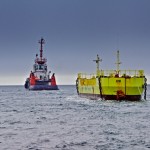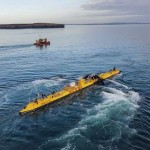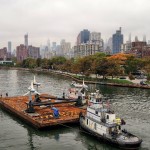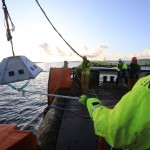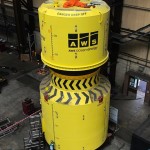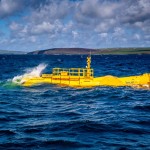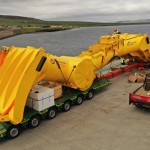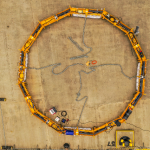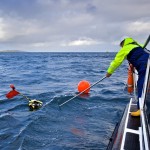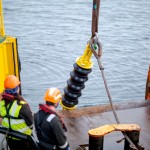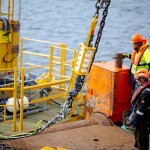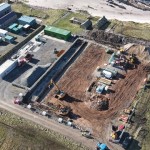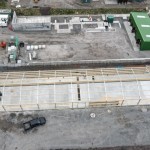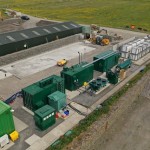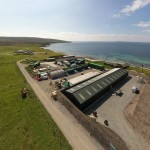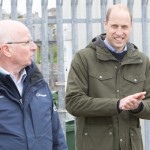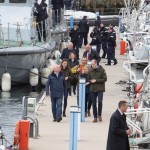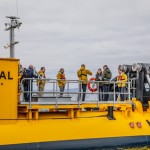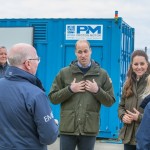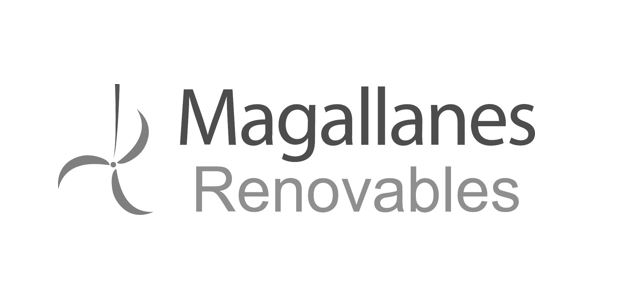Blog: 2021 review
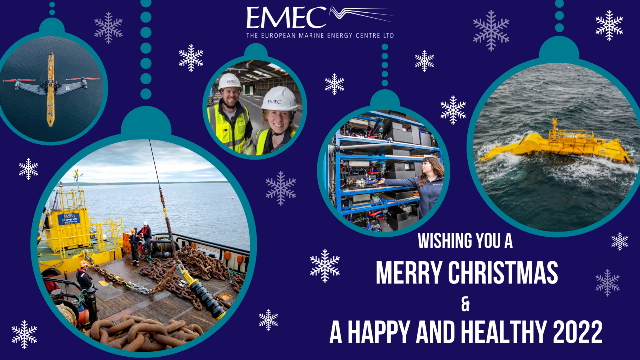
2021 has been a ‘big year’. COP26 brought the attention of the world back to the increasingly desperate need to decarbonise our economy. The spotlight was therefore very much on Orkney and EMEC’s work, customers and partners in a big way. This gave us an excellent opportunity to show all that we are involved in, often to the amazement of the journalists concerned, and we are sure that this will lead to further calls for our participation in more and more activities.
And it has been really busy. Not only have we seen the deployment of three marine energy devices at our sites, we have seen the return of our electrolysis plant and the construction of our ‘flow battery’ building on Eday with a view to being up and running early in 2022. EMEC’s expertise is being widely used in the 40+ live projects we have underway ranging from a hydrogen engine at the airport to supporting the Isle of Wight access its tides, and a lot in between. Many of our projects have represented ‘repeat business’ – a reassuring sign that we are doing what our clients want. We have of course encountered a slew of challenges and barriers along the way, some of which we’ve overcome, others we’re still working on, but that is the nature of operating a test site. If it was easy, we wouldn’t be here.
EMEC continues to grow and we’re now a team of over 70 people, more than double where we were just four years ago.
And others have recognised what we have been doing with awards galore and interest ranging from Royalty and Ministers of both Governments through to investors, the general public, holidaymakers and school kids.
But of course, it is not just what EMEC has done; it is a team effort of the supply chain, of clients, of partners and the wider community. Without their support and participation our best endeavours would come to nothing.
So, as we approach the end of another year fraught by COVID and anticipate a more open 2022, we look back at a year of real achievement and recognition. I firmly believe we can be proud in what we have achieved and confident that we will continue to make a real difference in the coming years.
Thanks to everybody who played any part in getting to here. Enjoy the break and get some rest – next year promises to be busier and even more exciting!
Neil Kermode, Managing Director
Ocean energy
Tidal energy
2021 has been a significant year for tidal energy both here at EMEC and, with the recent announcement of government backing for tidal power, for the industry as a whole.
In Orkney, we have seen two major deployments at our Fall of Warness test facility. In April, we welcomed back Spanish developer Magallanes Renovables as they reinstalled the ATIR tidal platform, demonstrated as part of our Interreg Ocean DEMO project. The 1.5 MW device underwent maintenance and optimisation at a dry dock in Edinburgh during 2020, having initially been deployed in 2019, so it was great to see it back and connected to the grid once again. Finishing the year on a high note, Magallanes has received a £1.2 million grant by the British Energy Entrepreneurs Fund to design the next generation of the ATIR.
We also welcomed Orbital Marine Power back to EMEC with a new device. The 2 MW O2 floating turbine, the world’s most powerful tidal turbine, is due to operate at EMEC for the next 15 years. Built in Dundee with 80% UK supply chain content, the 74 metre long O2 was towed to Orkney in April, and began exporting power to the UK grid at EMEC’s Fall of Warness test site in July. If you’d like to learn more about the development and deployment of the O2, check out the webinar we hosted as part of the Horizon 2020 FloTEC project.
Another highlight was the launch of the Orbital-led €26.7m Horizon 2020 FORWARD-2030 project in which EMEC will be delivering an unprecedented environmental monitoring programme and operational forecasting research. The project will see the development of the world’s most powerful floating tidal array as Orbital develop its next generation turbine to be deployed alongside the O2. Gaining this funding was a major triumph for the tidal energy industry, with our bid coming out on top of several O&G and electricity majors.
We’ve been expanding our operations outside of Orkney with EMEC leading the reconsenting works at the Perpetuus Tidal Energy Centre (PTEC) in the Isle of Wight. A huge amount of effort went into an updated Section 36 consent application, full planning application, Environmental Impact Assessment and SSEN grid application; these efforts were rewarded in December as the site was granted planning permission. The site is now eligible to bid into the government’s Contracts for Difference scheme.
PTEC is one of the sites being developed as part of the Interreg Channel Manche TIGER project. As well as the works at PTEC, we have been progressing with ADCP campaigns at Yarmouth and Raz Blanchard, as well as tidal resource modelling of the channel region and providing technical support for the TIGER partners. Additionally, EMEC has been supporting the growth of the tidal energy supply chain, coordinating a series of supply chain webinars, and working with the investment community to reduce risk and increase confidence in the sector.
Following EMEC being designated Renewable Energy Testing Laboratory (RETL) status in 2020, we delivered the world’s first international power performance assessment for Verdant Power’s New York tidal power array. COVID-19 restrictions meant we had to work remotely with the Verdant team, requiring the extensive use of computer and video security measures to process and quality control data and undertake performance analysis.
Wave energy
Mocean Energy’s Blue X arrived in Orkney in May 2021. Funded by Wave Energy Scotland’s (WES) Novel wave energy converter (WEC) programme and supported by Interreg North-West Europe’s Ocean DEMO project, the 20-metre long, 38-tonne wave machine was fabricated wholly in Scotland. The device was installed at our Scapa Flow test site in June and spent 154 days at sea operating in sea states up to 2.3 metres maximum wave height [Hs max], delivering steady outputs of up to 5 kW and safe instantaneous peaks of 30 kW. Mocean completed its trials in November bringing the machine to Hatston Pier to be cleaned, inspected, and readied for tests in 2022.
Also part of WES’s Novel WEC programme, we’ve worked closely with AWS Ocean Energy to help gear up to deploy the Archimedes Waveswing WEC at EMEC in early 2022.
We’ve been eagerly following the progress of EuropeWave which announced the projects to progress through Stage 1 of the R&D programme. The programme will culminate with wave energy developers coming to test at EMEC and the Biscay Marine Energy Platform (BiMEP) in the coming years.
Floating wind
We have been working closely with a major Scottish consortium supporting their bid for an offshore wind project west of Orkney. The 2 GW West of Orkney Windfarm proposal is the culmination of five years of engagement between the consortium and stakeholders in Caithness and Orkney including Orkney Harbour Authority and the Scrabster Harbour Trust. As part of the bid, an exclusive Memorandum of Understanding was signed with EMEC formalising a long-standing relationship in technical innovation and environmental data collection, building on EMEC’s unique marine energy research and development facilities and capabilities.
Real sea testing & demonstration
As well as demonstrating ocean energy converter technologies, EMEC’s sites have been busy this year with subsystem demonstrations and environmental monitoring activities.
We launched a series of acoustic surveys to monitor noise levels of the marine energy technologies at our sites to establish whether exposure to noise from technologies could result in behavioural changes to marine animals. EMEC deployed static and drifting hydrophones (underwater microphones) to characterise the acoustic signature of devices during operation. Our Consenting and Environment Team has undertaken initial data analysis to better understand any potential impacts with further surveying activities due in the new year. The studies aim to improve regulator confidence when consenting future technologies in the sector.
The EMEC-led Interreg Ocean DEMO project continues to support technology demonstrations across North-West Europe. At EMEC, as well as enabling the testing of Magallanes and Mocean’s devices, it also supported the University of Edinburgh’s demonstration of its multi-sensor flow measurement platform, developed under the RealTIDE project. Deployed at EMEC’s Fall of Warness test site over the summer, the system features a novel large-scale convergent beam acoustic Doppler profiler (C-ADP), six independent flow-measurement sensors and two ADPs operating autonomously via customised on-board computers. The system aims to improve flow measurement to better understand the fluid behaviour, including wave, currents and turbulence, in the vicinity of offshore technologies.
We’ve also played host to TFI’s mooring demonstrations, with two devices deployed on our test support buoy in Shapinsay Sound: the D400 (a load bearing spring) and the Gator (a polymer spring pump driving a hydro-electric system). To capture live data, EMEC built a bespoke wind and solar power system on the test support buoy to power EMEC’s data acquisition system and instrumentation, giving detailed insight into each devices performance.
InnoTECUK demonstrated the RoBFMSII robotic solution for inspecting and cleaning biofouling on the Magallanes and Pelamis devices.
Through the Marine Energy Alliance (MEA) project, EMEC has been working with 16 early-stage technology developers to de-risk development prior to demonstration at sea, delivering a range of services aimed at aligning early-stage testing with international standards and providing technical assessments. We completed an accredited inspection of Dublin Offshore’s mooring load reduction device assuring compliance with international mooring standards, and have a pipeline of accredited inspections through projects like OESA and BlueGIFT to support industry alignment to emerging international standards; more on that in 2022.
Green hydrogen
We’ve seen a gear shift in support for hydrogen at policy level and increased discussion in mainstream media recognising the key role it plays in the toolbox for achieving net zero. The UK Hydrogen Strategy was released in August with an accompanying Action Plan due in the new year, and the Scottish Government released its draft Hydrogen Action Plan outlining a five-year programme to help build Scotland’s hydrogen economy with a focus on supporting regional renewable hydrogen production hubs and renewable hydrogen projects.
Orkney hydrogen projects are highlighted as case studies in both publications and EMEC is pleased to see commitments from both governments for continued investment into research, development and demonstration projects in order to generate evidence around hydrogen production and use, as well as acknowledgement of the regulatory barriers around innovation.
Site activity
This summer saw a huge amount of construction activity at our onshore Caldale site on Eday, keeping our Operations Team very busy. We’ve expanded the site with the construction of a building to house the 48 vanadium flow batteries which will be delivered by our supplier Invinity Energy Systems early in the new year. The battery technology will be integrated with tidal energy to store electricity generated by tidal turbines during high power periods, and discharge it during low power periods, to optimise green hydrogen production.
Our upgraded electrolysis plant has returned on site and we’re supporting ITM to recommission the plant. This site work is being supported by the Interreg North-West Europe ITEG project which will also see the arrival of a second electrolyser on Eday next summer to demonstrate an integrated tidal energy and hydrogen production solution.
In addition to physical site upgrades, EMEC has been involved in data-driven research with the aim of making hydrogen production “smarter”. Collaborating with H2GO Power, developers of low-pressure hydrogen energy storage and AI-driven asset management, the HyAI project demonstrated the use of AI (artificial intelligence) software-controlled hydrogen storage technology. EMEC supplied energy data from the hydrogen production plant to develop and train the AI software model which integrates data about weather, electricity prices and grid management to optimise hydrogen storage and production. We look forward to continued work in this space in the new year.
Maritime decarbonisation
EMEC continues to progress hydrogen research opportunities to support the decarbonisation of the wider energy system across power, heat and transport, with heavy duty transport a key focus.
The HIMET project kicked off in September which was one of 55 UK projects funded by the Department for Transport’s flagship Clean Maritime Demonstration Competition. Led by EMEC, HIMET is progressing an ambitious programme of activities centred on the decarbonisation of two key local maritime sectors – ferry services and cruise terminal operations.
As part of the HyDIME project, a first of a kind hydrogen training course was developed to equip mariners with the necessary skills and knowledge to work on board hydrogen fuelled ships. The course was written and delivered by Orkney College UHI’s Maritime Studies department in collaboration with local partners – EMEC and Orkney Ferries – and approved by the Maritime and Coastguard Agency (MCA).
Aviation
In late 2020, EMEC delivered Europe’s first ADR-certified mobile refuelling solution to support test flights at part of the HyFlyer flight test programme. Throughout 2021, our mobile hydrogen refueller has been supporting the HyFlyer programme at ZeroAvia’s R&D facility in Kemble, where they are scaling up testing to demonstrate a hydrogen powertrain for a 19-seat aircraft. Congratulations to our refueller electrolyser supplier, Enapter, for being named as one of the inaugural winners of the Earthshot prize in October – a prestigious environmental award launched by The Royal Foundation of The Duke and Duchess of Cambridge – for its innovative AEM modular electrolyser.
Orkney is also now the setting of a sustainable aviation test centre at Kirkwall Airport thanks to the launch of the SATE project. Led by HIAL, the project is trialling a host of low-carbon aviation technologies. To facilitate this, EMEC has supported HIAL with the delivery of new ground infrastructure at the airport including a SATE hangar and charging facilities. Two technology developers completed trials in 2021: US company Ampaire conducted test flights between Kirkwall and Wick, the first hybrid-electric aircraft demonstration in Scotland; and Windracers, developers of the unmanned autonomous vehicle ULTRA, delivered mail to the islanders of North Ronaldsay and Eday in collaboration with Royal Mail.
Looking beyond the technology on the runway, EMEC and HIAL are working together on further initiatives to decarbonise the airport groundside activities to enable HIAL to meet the Scottish Government’s target for the Highlands and Islands to be the world’s first net zero aviation region by 2040. A combined heat and power unit (CHP) is being commissioned to meet some of the heating and power requirements in the airport building.
EMEC also supported iGTL Technology in producing synthetic hydro-carbon fuel for use in aviation. iGTL built and operated a temporary synthetic gasoline demonstration plant onshore at EMEC’s Billia Croo wave test site. The plant used EMEC green hydrogen as feedstock to create a synthetic hydrocarbon fuel which, alongside partners Zero Petroleum and the Royal Air Force, was used to demonstrate the world’s first flight to be powered entirely by synthetic aviation fuel, earning a place in the Guinness World Record books.
Replication
Through interconnected pilot projects in Orkney, EMEC has built collective hydrogen know-how across the value chain, from production through to storage, transport, supply and end use. The knowledge garnered is helping to drive hydrogen innovation at an international level, with EMEC supporting several projects replicate and scale up hydrogen ecosystems elsewhere.
The HEAVENN project is building a hydrogen valley in the northern Netherlands, and Green Hysland is developing a hydrogen ecosystem in Mallorca. We are also building industry relationships in France with our Franco-Scottish report for The Scottish Government studying supply chains in Scotland and France to support collaborative innovation and resolve shared technical challenges. This report even got acknowledged by the First Minister during a speech a COP26.
Commercial developments
Hydrogen R&D projects in Orkney have instigated significant private sector interest with a major consortium looking at how to repurpose the local Flotta oil terminal to create a green hydrogen hub. Powered by offshore wind, the plans would contribute significantly to the UK’s low carbon ambitions, create long-term skilled jobs and place Scotland front and centre of the evolving global hydrogen revolution. EMEC has been supporting the project consortium, Offshore Wind Power Limited (OWPL), in partnership with Flotta Terminal’s owner Repsol Sinopec, and Uniper.
Energy systems
The EMEC-led ReFLEX Orkney project has had a whirlwind of a year, making great strides forward but also facing a number of challenges, particularly on the regulation front but also hampered by COVID and the post-Brexit fall out on the supply chain and energy prices.
However a year into launching a local energy company as part of the project, it is nearing 800 members and has brought over 100 electric vehicles into Orkney spanning lease cars, car club and community vehicles. ReFLEX also launched a new Orkney-specific carbon calculator to help the Orkney community estimate its carbon footprint and monitor it over time.

This year also saw the launch of the Islands Growth Deal which will see £100 million investment from the UK and Scottish governments in the future economic prosperity of Orkney, Shetland and the Outer Hebrides. EMEC is a key delivery partner for the Islands Growth Deal and is leading the development of the Islands Centre for New Zero, one of the key low carbon initiatives in the deal. The outline business case has been submitted and, pending approval, the Centre will be launched later in 2022.
Pioneering a new low carbon future
We have attracted significant media interest over the last year, especially in the run up to COP26, for our efforts, and our partners’, in pioneering a new low carbon future. Media coverage spans local, national and international broadcasts from the BBC to ABC News, Aljazeera to TV Tokyo, and publications include The Engineer, Power Engineering International and European Energy Innovation to name but a few. We even received feedback that Neil Kermode’s interview on the BBC Newscast podcast had been listened to by Prince William.
Speaking of whom, a major highlight was having the future King and Queen of Great Britain visit us in May when they christened the O2 tidal turbine and were shown around our hydrogen fuel cell in Kirkwall. Discussions focussed on solutions for tackling climate change and supporting the UK’s green economic recovery, and EMEC has recently been asked to be a nominator for The Earthshot Prize which was launched by The Duke of Cambridge in 2020. More detail on that coming early 2022.
For the last few years, alongside the UK’s Marine Energy Council, EMEC has been tirelessly lobbying the UK government to put in place the required revenue support and R&D funding mechanisms to help ocean energy commercialise, retain the UK’s leading position in the marine energy sector and ensure the UK takes full advantage of its ocean energy resources. We were delighted to welcome the UK Energy Minister, Anne-Marie Trevelyan MP, the Under Secretary of State for Scotland, David Duguid MP and Members of the House of Commons Scottish Affairs Committee to Orkney, among numerous other MPs and civil servants in 2021. Decisions ran right up to the final hour so it was a great relief to hear that the UK Government would be investing £20 million per year across the UK in tidal stream electricity as part of its Contracts for Difference (CfD) scheme.
The year has been rounded out with a series of awards in recognition for these efforts and all the work being done across our sites and projects. It was an honour to be named Blue Economy Enterprise of the Year at The SHIREs (Scottish Highlands and Islands Rural Economy) Awards, and Champion of Renewables at the Scottish Green Energy Awards. And then to top the year off, our Managing Director, Neil Kermode, was awarded the Lennard-Senior Prize by The Society for Underwater Technology for the second time.
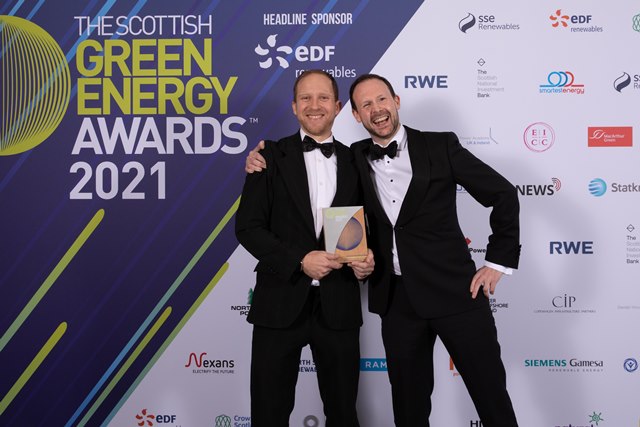
Matthew Finn and Rob Flynn accepting Champion of Renewables award
Wishing our community, clients, project partners, suppliers, funders and supporters from around the world a very merry Christmas and a happy and healthy 2022!
